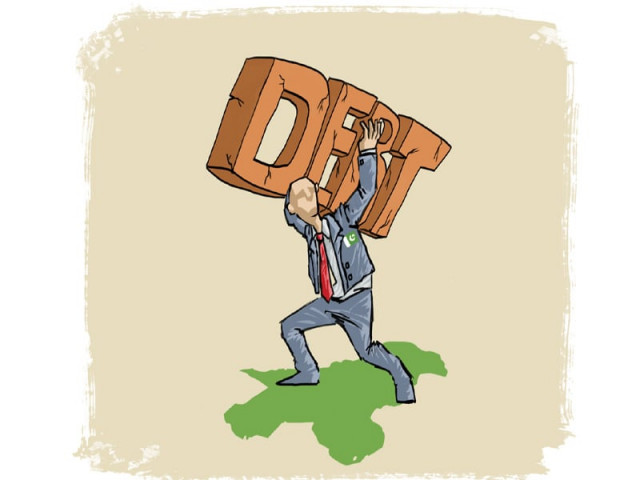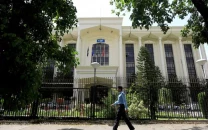Total debt, liabilities peak to Rs44.5tr
Pakistan’s debt level increases by Rs14.6tr in two years, shows SBP data

Pakistan’s total debt and liabilities skyrocketed to Rs44.5 trillion by June this year, an addition of a whopping Rs14.6 trillion or 49% compared with the debt burden two years ago, the State Bank of Pakistan (SBP) reported on Thursday.
The Rs44.5 trillion total debt and liabilities were equal to 106.8% of gross domestic product (GDP), which was the highest level in the past 20 years and was a grim reminder of the period when the country was on the verge of default. It was for the second successive year that Pakistan’s total debt and liabilities were higher than the size of its economy.
In 2000, the country’s total debt and liabilities were equal to 106% of GDP. Statistics released by the SBP showed that by the end of last fiscal year, the country’s total debt and liabilities soared to Rs44.5 trillion. Within a span of just two years, there was an increase of Rs14.6 trillion, or 48.8%, in the overall debt and liabilities.
Excluding the liabilities, the country’s total debt swelled to Rs42.1 trillion, up Rs13.7 trillion or 48.2% in two years.
The primary reason for the high total debt was the public debt-toGDP ratio, which was equal to 87.2% of GDP by June this year. Total debt and liabilities also include the public sector enterprises’ (PSEs) debt, non-governmental external debt and inter-company external debt from direct investors abroad.
To a question raised by The Express Tribune early last year, Prime Minister Imran Khan said one of the benchmarks of his success would be reduction in the total debt and liabilities from Rs30 trillion to Rs20 trillion.
The Pakistan Tehreek-e-Insaf (PTI) government had set Rs4.4 trillion tax collection target for its first year in power but closed the year with receipts of Rs3.826 trillion. Then for its second year, the government set the tax collection target at Rs5.555 trillion but actual collection remained at Rs4 trillion.
Cumulatively, the PTI government collected Rs2 trillion less than what it had aimed for, which contributed to a surge in the debt level. The second reason was the unsustainable interest rate set by the central bank that pushed the cost of debt servicing too high. Lastly, a steep currency devaluation added Rs3.5 trillion to the public debt in just two years.
Another dangerous development was a 66% increase in the debt of PSEs within two years as the PTI government neither reformed the loss-making entities nor could it privatise them. PSEs’ total debt, which was Rs1.39 trillion in June 2018, grew to Rs2.3 trillion by June this year, according to the central bank.
There was an increase of Rs922 billion or 66.2% in the PSEs’ debt. PSEs’ external debt jumped by Rs500 billion or 154% to Rs824 billion in two years. Domestic debt of the PSEs amounted to Rs1.5 trillion with an addition of 40% in two years.
The government had incorporated Sarmaya-e-Pakistan Limited (SPL) to revive the loss-making companies. But SPL has remained dysfunctional for the past 14 months after six of its directors, including the chairman, resigned due to a lack of clarity over government’s policies, according to their resignation letters seen by The Express Tribune.
The external debt and liabilities of Pakistan mounted to $112.8 billion as of June 2020, according to the central bank. Of the Rs44.5 trillion, the gross public debt, which was the direct responsibility of the government, stood at Rs36.4 trillion as of the end of June.
The gross public debt was now equal to 87.2% of GDP, far higher than the 60% statutory limit set in the Fiscal Responsibility and Debt Limitation Act of 2005. The government’s domestic debt surged to Rs23.2 trillion with the addition of Rs6.8 trillion in the last two fiscal years. Its external public debt increased to a record Rs11.8 trillion, an addition of Rs4 trillion or 51.2%.
Total external debt and liabilities surged to Rs17.3 trillion on the back of currency depreciation and new borrowings. There was an increase of Rs6.4 trillion or 58.7% in the external debt and liabilities in two years.
The debt taken by Pakistan from the International Monetary Fund (IMF) increased in rupee terms by Rs551 billion to Rs1.3 trillion in two years due to a steep currency devaluation and new borrowings. The rupee lost its value by Rs46.66 or 39% in two years and traded at over Rs168 to a dollar by the end of June this year.



















COMMENTS
Comments are moderated and generally will be posted if they are on-topic and not abusive.
For more information, please see our Comments FAQ